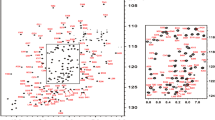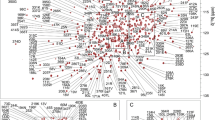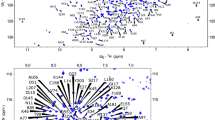Abstract
Lipocalin-type prostaglandin (PG) D synthase (L-PGDS) catalyzes the isomerization of PGH2 to produce PGD2, an endogenous somenogen, in the brains of various mammalians. We recently reported that various other PGs also bind to L-PGDS, suggesting that it could serve as an extracellular carrier for PGs. Although the solution and crystal structure of L-PGDS has been determined, as has the structure of L-PGDS complexed PGH2 analog, a structural analysis of L-PGDS complexed with other PGs is needed in order to understand the mechanism responsible for the PG trapping. Here, we report the nearly complete 1H, 13C, and 15N backbone and side chain resonance assignments of the L-PGDS/PGJ2 complex and the binding site for PGJ2 on L-PGDS.
Similar content being viewed by others
Explore related subjects
Discover the latest articles, news and stories from top researchers in related subjects.Avoid common mistakes on your manuscript.
Biological context
Lipocalin-type prostaglandin (PG) D synthase (L-PGDS; EC 5.3.99.2) is isolated from the rat brain and identified as the PGD2 synthesizing enzyme (Urade et al. 1985). L-PGDS is abundantly expressed in the central nervous system of various mammals, male genitals, human heart, and mouse adipocytes (Fujimori et al. 2007), and is the second most abundant protein after serum albumin in human CSF (Clausen 1961; Xu and Venge 2000). In addition, it has also been revealed that L-PGDS is the only enzyme among members of the lipocalin gene family that is composed of a group of lipid-transporter proteins (Toh et al. 1996; Urade and Hayaishi 2000). L-PGDS binds a large variety of ligands, such as retinoids (Tanaka et al. 1997), biliverdin, bilirubin, thyroid hormones (Beuckmann et al. 1999), gangliosides (Mohri et al. 2006), and amyloid β peptide (Kanekiyo et al. 2007). L-PGDS is thus thought to be a multifunctional protein possessing both the ability to synthesize PGD2 and to serve as a carrier protein for lipophilic molecules.
Mouse L-PGDS is a 189 amino acid protein, and is post-translationally modified by the cleavage of an N-terminal signal peptide comprising 24 amino acid residues (Hoffmann et al. 1996; Urade and Hayaishi 2000). Mouse L-PGDS contains three cysteine residues, Cys65, Cys89, and Cys186. These three cysteine residues are conserved among all mammals. Two of these Cys residues, Cys89 and Cys186, form a disulfide bridge, which is highly conserved among most lipocalins. On the other hand, Cys65 residue is unique to L-PGDS and is essential for the catalytic reaction (Urade et al. 1995; Irikura et al. 2003). In previous mutational and structural studies, we reported that L-PGDS has a large hydrophobic cavity in its β-barrel fold and two substrate binding sites are present in the cavity (Shimamoto et al. 2021). In an isothermal titration calorimetry (ITC) analysis, we showed that L-PGDS binds not only its substrate, PGH2, but also to various other PGs, such as PGD2, PGE2, and PGF2α (Shimamoto et al. 2021). The affinity of some PGs (Kd = 0.3 ~ 3 μM) was higher than those of thyroid hormones (Kd = 0.5 ~ 6 μM), endogenous ligands of L-PGDS (Beuckmann et al. 1999), suggesting that L-PGDS has the ability to transport PGs (Shimamoto et al. 2021).
The PGD2, produced by L-PGDS, is chemically unstable and readily undergoes non-enzymatically dehydration to produce the J series of PGs, such as PGJ2, Δ12-PGJ2, and 15-deoxy-Δ12,14-PGJ2 (Fitzpatrick and Wynalda 1983; Kikawa et al. 1984). These PGJs are actively taken into cells and accumulated in the nuclei, and especially 15-deoxy-Δ12,14-PGJ2 is known as a natural activator for the peroxisome proliferator-activated receptor γ (PPARγ) (Kliewer et al. 1995).
The mechanism by which L-PGDS recognizes PG is not fully understood, because a structural analysis of L-PGDS in complex with PGs, except for the substrate analog, remains to be performed. In this study, we report that 15-deoxy-Δ12,14-PGJ2, which is nonenzymatically derived from PGD2, binds to L-PGDS by NMR and present the nearly complete assignment of the backbone and side chain resonances of the L-PGDS/15-deoxy-Δ12,14-PGJ2 complex.
Methods and experiments
The gene corresponding to Δ1-24 mouse L-PGDS (165 residues) was synthesized and inserted into a bacterial expression vector pGEX-2T and transformed into Escherichia coli BL21(DE3) cells. The transformed colonies were grown in 3 mL of LB medium containing 100 mg/L of ampicillin at 37 °C for 4 h. One milliliter of the bacterial culture was diluted in 1 L of M9 minimal medium containing 15N ammonium chloride (1 g/L) and/or 13C glucose (2 g/L) as the sole nitrogen and carbon sources. The bacterial culture was grown at 37 °C to an optical density at 600 nm of 0.6. After induction with 1 mM isopropyl-β-D-thiogalactopyranoside, the protein was expressed as a glutathione S-transferase fusion protein in BL21(DE3) cells for 5 h at 37 °C. The cells were harvested by centrifugation for 30 min at 4000×g at 4 °C, resuspended in 30 mL of PBS and sonicated in 4 °C. The bacterial lysate was clarified by centrifugation at 20,000×g for 30 min at 4 °C. The protein was purified by affinity chromatography with Glutathione Sepharose 4B (GE Healthcare, Tokyo, Japan) and size-exclusion chromatography with Superdex 75 (GE Healthcare, Tokyo, Japan), as reported previously (Inui et al. 2003). The L-PGDS/15-deoxy-Δ12,14-PGJ2 complex sample was prepared by incubating a 1:1 ratio of L-PGDS and 15-deoxy-Δ12,14-PGJ2 (Cayman, CA, USA). The complex sample were dialyzed and concentrated to approximately 0.5 mM in the NMR buffer (50 mM sodium phosphate, D2O or an 85% H2O/15% D2O, pH 6.5).
To perform backbone and side chain resonance assignments of the L-PGDS/15-deoxy-Δ12,14-PGJ2 complex, all 2D and 3D NMR experiments were carried out at 25 °C on an INOVA600 with a triple resonance 1H/13C/15N cryoprobe. Backbone assignments were obtained from the standard double and triple resonance NMR experiments, 1H-15N HSQC, CBCA(CO)NH and HNCACB (Bax et al. 1994; Kay 1995). Side chain assignments were achieved by measurement of 1H-13C HSQC, HBHA(CO)NH, HCCH-TOCSY and CCH-TOCSY. All spectra were processed with NMRPipe (Delaglio et al. 1995). Resonance assignment was performed using the NMRviewJ (Merck Research Laboratories).
Extent of assignments and data deposition
Using the sequence-specific backbone assignments, 84% 1HN, 84% 15N, 91% Cα, and 90% Cβ chemical shifts were assigned for the L-PGDS/15-deoxy-Δ12,14-PGJ2 complex (Fig. 1). Signals for several residues in the N-terminus and loops (e.g., Gln25, Gly26, His27, Ser53, Trp54, Asn124, and Tyr125) were missing from the 1H-15N HSQC presumably due to ms-μs exchange line broadening and/or exchange with the solvent. These residues are also not defined in apo-L-PGDS (Shimamoto et al. 2007). For the aliphatic side chain moieties of the protein, 84% 1H and 85% 13C were assigned. The chemical shifts have been deposited in the BioMagnResBank (http://www.bmrb.wisc.edu) under the accession number 51128.
In a comparison of the 1H-15N HSQC spectrum of L-PGDS/15-deoxy-Δ12,14-PGJ2 complex with apo-L-PGDS, numerous peaks in the HSQC showed significant perturbations upon 15-deoxy-Δ12,14-PGJ2 addition, suggesting that 15-deoxy-Δ12,14-PGJ2 binds to L-PGDS. Upon 15-deoxy-Δ12,14-PGJ2 binding, large chemical shift changes were observed at the catalytic site that is comprised of 7 residues, the Cys65 catalytic center, Ser45, Ala46, Gly47, Tyr63, Met64, and Phe83 (Shimamoto et al. 2021). In addition, the chemical shifts for 12 residues (Val95, Leu96, Ser108, Ser114, Ile115, His116, Ser117, Val118, Ser119, Leu130, Ser133, and Gly135) were changed substantially (Fig. 2A). These residues are located at the high affinity substrate binding site which is involved in trapping the substrate into the cavity during the catalytic reaction (Shimamoto et al. 2021). These results suggest that 15-deoxy-Δ12,14-PGJ2 has the potential to inhibit L-PGDS activity.
Chemical shift perturbations of the 1H-15N HSQC spectrum of L-PGDS upon the binding of 15-deoxy-Δ12,14-PGJ2. A 1H and 15N chemical shift differences versus the amino acid sequence. The chemical shift differences were calculated according to the empirical equation Δppm = {(ΔδHN × WHN)2 + (ΔδN × WN)2}1/2 where‚ ΔδHN and ΔδN are the chemical shift changes of 1H and 15N, respectively. The weighting factors used were WHN = 1, WN = 0.2. The residues with relatively large changes in chemical shift (Δppm ≥ 0.2) are highlighted in red. B Mapping of NMR signal perturbation on L-PGDS backbone structure by binding of 15-deoxy-Δ12,14-PGJ2. Backbone residues with relatively large changes in chemical shift (Δppm ≥ 0.2) are shown in red, whereas residues whose signals disappeared upon the binding of 15-deoxy-Δ12,14-PGJ2 are shown in blue. Magenta dotted ellipses indicate the catalytic binding site of the PGH2 substrate
In our previous study, we elucidated the binding of L-PGDS to several ligands, such as PGs (Shimamoto et al. 2007, 2021), NADs (Qin et al. 2015), retinoic acid (Shimamoto et al. 2007) and biliverdin (Miyamoto et al. 2010) by NMR titration experiments and demonstrated that high affinity ligands, such as retinoic acid and biliverdin (Kd < 0.1 μM), caused a significant broadening of the resonances of L-PGDS (Shimamoto et al. 2007; Miyamoto et al. 2010). In the 1H-15N HSQC spectrum of the L-PGDS/15-deoxy-Δ12,14-PGJ2 complex, the HN signals of 13 residues disappeared due to the signal broadening and these residues were close to the residues that showed large chemical shift changes (Fig. 2B). This suggests that 15-deoxy-Δ12,14-PGJ2 binding as well as biliverdin binding cause significant broadening in signals for residues in the binding site.
Abbreviations
- CSF:
-
Cerebrospinal fluid
- ITC:
-
Isothermal titration calorimetry
- L-PGDS:
-
Lipocalin-type prostaglandin D synthase
- PG:
-
Prostaglandin
- PPARγ:
-
Peroxisome proliferator-activated receptor γ
References
Bax A, Delaglio F, Grzesiek S, Vuister GW (1994) Resonance assignment of methionine methyl groups and chi 3 angular information from long-range proton-carbon and carbon-carbon J correlation in a calmodulin-peptide complex. J Biomol NMR 4(6):787–797
Beuckmann CT, Aoyagi M, Okazaki I, Hiroike T, Toh H, Hayaishi O, Urade Y (1999) Binding of biliverdin, bilirubin, and thyroid hormones to lipocalin-type prostaglandin D synthase. Biochemistry 38(25):8006–8013
Clausen J (1961) Proteins in normal cerebrospinal fluid not found in serum. Proc Soc Exp Biol Med 107:170–172. https://doi.org/10.3181/00379727-107-26569
Delaglio F, Grzesiek S, Vuister GW, Zhu G, Pfeifer J, Bax A (1995) NMRPipe: a multidimensional spectral processing system based on UNIX pipes. J Biomol NMR 6(3):277–293
Fitzpatrick FA, Wynalda MA (1983) Albumin-catalyzed metabolism of prostaglandin D2. Identification of products formed in vitro. J Biol Chem 258(19):11713–11718
Fujimori K, Aritake K, Urade Y (2007) A novel pathway to enhance adipocyte differentiation of 3T3-L1 cells by up-regulation of lipocalin-type prostaglandin D synthase mediated by liver X receptor-activated sterol regulatory element-binding protein-1c. J Biol Chem 282(25):18458–18466. https://doi.org/10.1074/jbc.M701141200
Hoffmann A, Bachner D, Betat N, Lauber J, Gross G (1996) Developmental expression of murine Beta-trace in embryos and adult animals suggests a function in maturation and maintenance of blood-tissue barriers. Dev Dyn 207(3):332–343
Inui T, Ohkubo T, Emi M, Irikura D, Hayaishi O, Urade Y (2003) Characterization of the unfolding process of lipocalin-type prostaglandin D synthase. J Biol Chem 278(5):2845–2852
Irikura D, Kumasaka T, Yamamoto M, Ago H, Miyano M, Kubata KB, Sakai H, Hayaishi O, Urade Y (2003) Cloning, expression, crystallization, and preliminary X-ray analysis of recombinant mouse lipocalin-type prostaglandin D synthase, a somnogen-producing enzyme. J Biochem 133(1):29–32
Kanekiyo T, Ban T, Aritake K, Huang ZL, Qu WM, Okazaki I, Mohri I, Murayama S, Ozono K, Taniike M, Goto Y, Urade Y (2007) Lipocalin-type prostaglandin D synthase/beta-trace is a major amyloid beta-chaperone in human cerebrospinal fluid. Proc Natl Acad Sci U S A 104(15):6412–6417
Kay LE (1995) Pulsed field gradient multi-dimensional NMR methods for the study of protein structure and dynamics in solution. Prog Biophys Mol Biol 63(3):277–299
Kikawa Y, Narumiya S, Fukushima M, Wakatsuka H, Hayaishi O (1984) 9-Deoxy-delta 9, delta 12–13,14-dihydroprostaglandin D2, a metabolite of prostaglandin D2 formed in human plasma. Proc Natl Acad Sci U S A 81(5):1317–1321. https://doi.org/10.1073/pnas.81.5.1317
Kliewer SA, Lenhard JM, Willson TM, Patel I, Morris DC, Lehmann JM (1995) A prostaglandin J2 metabolite binds peroxisome proliferator-activated receptor gamma and promotes adipocyte differentiation. Cell 83(5):813–819. https://doi.org/10.1016/0092-8674(95)90194-9
Miyamoto Y, Nishimura S, Inoue K, Shimamoto S, Yoshida T, Fukuhara A, Yamada M, Urade Y, Yagi N, Ohkubo T, Inui T (2010) Structural analysis of lipocalin-type prostaglandin D synthase complexed with biliverdin by small-angle X-ray scattering and multi-dimensional NMR. J Struct Biol 169(2):209–218
Mohri I, Taniike M, Okazaki I, Kagitani-Shimono K, Aritake K, Kanekiyo T, Yagi T, Takikita S, Kim HS, Urade Y, Suzuki K (2006) Lipocalin-type prostaglandin D synthase is up-regulated in oligodendrocytes in lysosomal storage diseases and binds gangliosides. J Neurochem 97(3):641–651
Qin S, Shimamoto S, Maruno T, Kobayashi Y, Kawahara K, Yoshida T, Ohkubo T (2015) Thermodynamic and NMR analyses of NADPH binding to lipocalin-type prostaglandin D synthase. Biochem Biophys Res Commun 468(1–2):234–239. https://doi.org/10.1016/j.bbrc.2015.10.124
Shimamoto S, Yoshida T, Inui T, Gohda K, Kobayashi Y, Fujimori K, Tsurumura T, Aritake K, Urade Y, Ohkubo T (2007) NMR solution structure of lipocalin-type prostaglandin D synthase: evidence for partial overlapping of catalytic pocket and retinoic acid-binding pocket within the central cavity. J Biol Chem 282(43):31373–31379
Shimamoto S, Nakagawa Y, Hidaka Y, Maruno T, Kobayashi Y, Kawahara K, Yoshida T, Ohkubo T, Aritake K, Kaushik MK, Urade Y (2021) Substrate-induced product-release mechanism of lipocalin-type prostaglandin D synthase. Biochem Biophys Res Commun 569:66–71. https://doi.org/10.1016/j.bbrc.2021.06.092
Tanaka T, Urade Y, Kimura H, Eguchi N, Nishikawa A, Hayaishi O (1997) Lipocalin-type prostaglandin D synthase (beta-trace) is a newly recognized type of retinoid transporter. J Biol Chem 272(25):15789–15795
Toh H, Kubodera H, Nakajima N, Sekiya T, Eguchi N, Tanaka T, Urade Y, Hayaishi O (1996) Glutathione-independent prostaglandin D synthase as a lead molecule for designing new functional proteins. Protein Eng 9(12):1067–1082
Urade Y, Hayaishi O (2000) Biochemical, structural, genetic, physiological, and pathophysiological features of lipocalin-type prostaglandin D synthase. Biochim Biophys Acta 1482(1–2):259–271
Urade Y, Fujimoto N, Hayaishi O (1985) Purification and characterization of rat brain prostaglandin D synthetase. J Biol Chem 260(23):12410–12415
Urade Y, Tanaka T, Eguchi N, Kikuchi M, Kimura H, Toh H, Hayaishi O (1995) Structural and functional significance of cysteine residues of glutathione-independent prostaglandin D synthase. Identification of Cys65 as an essential thiol. J Biol Chem 270(3):1422–1428
Xu S, Venge P (2000) Lipocalins as biochemical markers of disease. Biochim Biophys Acta 1482(1–2):298–307. https://doi.org/10.1016/s0167-4838(00)00163-1
Acknowledgements
This study was supported, in part, by Grants 16K18868 (to S.S.) from Grant-in-Aid for Young Scientists (B).
Author information
Authors and Affiliations
Corresponding author
Ethics declarations
Conflict of interest
The authors declare that they have no known competing financial interests or personal relationships that could have appeared to influence the work reported in this paper.
Additional information
Publisher's Note
Springer Nature remains neutral with regard to jurisdictional claims in published maps and institutional affiliations.
Rights and permissions
About this article
Cite this article
Shimamoto, S., Nakahata, Y., Hidaka, Y. et al. NMR resonance assignments of mouse lipocalin-type prostaglandin D synthase/prostaglandin J2 complex. Biomol NMR Assign 16, 225–229 (2022). https://doi.org/10.1007/s12104-022-10084-5
Received:
Accepted:
Published:
Issue Date:
DOI: https://doi.org/10.1007/s12104-022-10084-5






